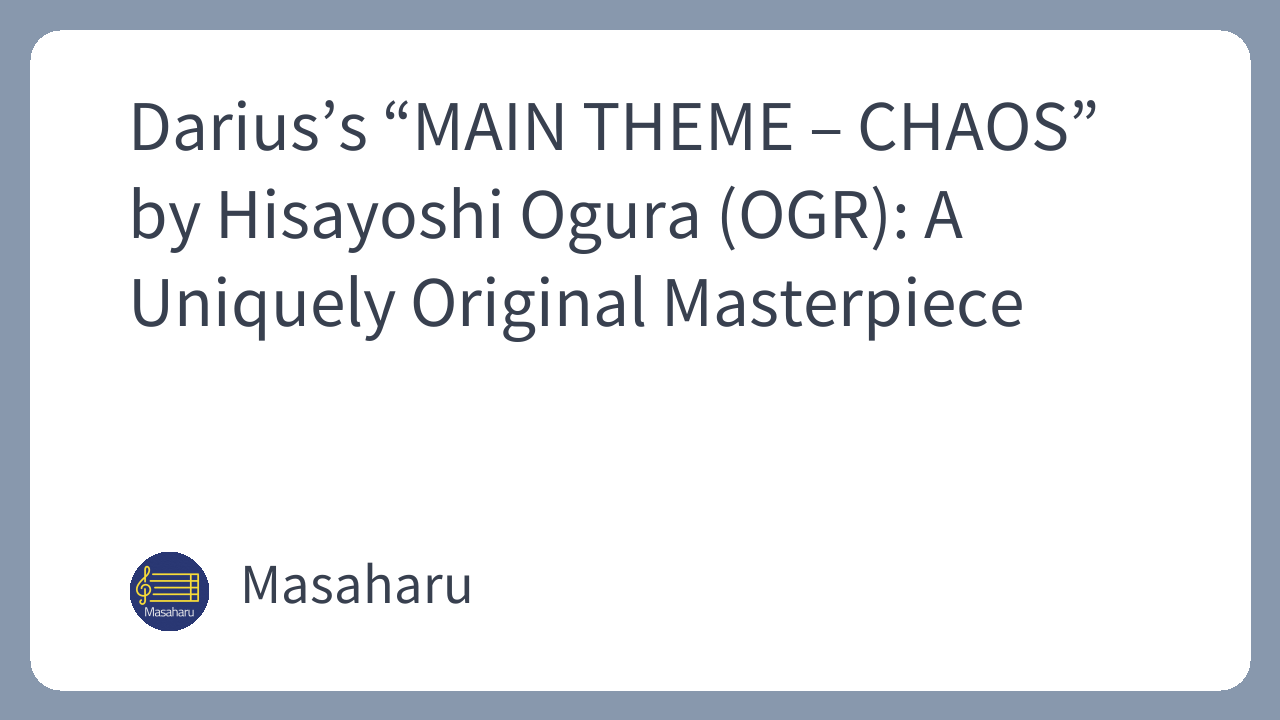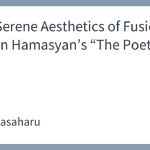The game music of the 1980s is home to a number of experimental and distinctive masterpieces, and “MAIN THEME – CHAOS” (hereafter “CHAOS”) from the 1987 game *Darius* is one of them.
This article will examine the achievements of Hisayoshi Ogura (also known as OGR), a noteworthy creator in the realm of game music, with a particular focus on “CHAOS” from *Darius*.
In the early days of the game music industry, Mr. Ogura continued to push beyond conventional frameworks. His work can be evaluated not merely as background music for games, but as artistic expression that established its own unique musical identity.
To discuss Mr. Ogura, *Darius*, and “CHAOS,” I would first like to start with the topic of ZUNTATA, the sound team at Taito to which he belonged.
The Trajectory of ZUNTATA: From Serendipity to Strategy
ZUNTATA, the sound team of major game manufacturer Taito, has brilliantly carved its name into the history of game music. The team’s birth reportedly stemmed from a suggestion by a record company producer at the time, who proposed that a “band-like format would be more inspiring.” Mr. Ogura himself initially viewed ZUNTATA as a temporary, “transient unit” for the production of the *Darius* album and stated that he did not anticipate its subsequent widespread recognition and continued activity.
However, riding the wave of the game music boom at the time, ZUNTATA achieved unexpected success. As a result, Mr. Ogura, foreseeing its long-term survival, came to emphasize the importance of “branding” ZUNTATA. It is said that he used strict criteria to screen works, even those produced by internal members, to maintain a “creative DNA” that matched ZUNTATA’s specific mood.
This strategic approach is thought to be why ZUNTATA maintained its unique presence while bands from other game companies ceased their activities. This history suggests that Mr. Ogura played the role not only of a composer but also of a visionary leader who oversaw the direction of sound production and artistic activities.
Redefining Game Music: A “Visual Media” Perspective
Mr. Ogura developed a unique philosophy towards game music. He viewed video games not just as something players “play,” but fundamentally as something they “watch”—in other words, as “visual media.” This perspective clearly indicates his stance that sound and visuals should coexist to actively enhance the player’s visual and experiential immersion.
Mr. Ogura reportedly had a clear goal to “wipe out and rebuild” the “common sense of game music” at the time. This goal was embodied in *Darius* in the form of a “considerable adventure,” featuring the frequent use of odd time signatures and unconventional structures. Mr. Ogura has said he was confident that this bold attempt would become a standard method in the future, a fact that demonstrates his progressive and experimental spirit.
It is also interesting that Mr. Ogura has expressed a critical view of the excessive reliance on orchestral sounds in modern game music, stating that it is “‘cheating’ the listener.” He poses a question to modern game creators: “Do you want to make a ‘game,’ or do you want to make a ‘movie knock-off’?” He argues that if cinematic elements are not truly integrated with the interactive nature of the game, their easy introduction will ultimately detract from the player’s experience.
This criticism resonates with modern discussions about the balance between the “linearity of experience” in movies and interactive gameplay, and it is thought to show his fundamental perspective on game music.
“Inorganic Sound” and the “Z-Axis”: The Sonic Depths of “CHAOS”
A definitive feature of the BGM of *Darius*, especially “CHAOS,” is that it is constructed by actively using both “real-world sounds given a unique presence” through low bit-rate, low-frequency sampled sound sources, and “inorganic electronic sounds” from an FM sound source. This unique sonic palette set *Darius* apart from its contemporaries and brought a strange, cosmic, and futuristic atmosphere.
In an interview, Mr. Ogura stated that he was conscious of “creating sound that would stand out in an arcade.” *Darius* is a work that remains strongly in people’s memories, partly due to its unique and unconventional arcade cabinet (a three-screen setup and a built-in subwoofer), and he had a deep understanding of the arcade cabinet’s hardware capabilities. For example, he understood and utilized sonic tendencies such as the bass frequencies being amplified by the system and the flanger effect derived from the synchronization of the two installed FM sound chips.
As a result, by composing “sparkling sequence phrases” and “phrases that cut through the mix” with the FM sound source, he not only produced highly musical pieces but also succeeded in creating music whose sound stood out effectively even in the clamor of a noisy arcade environment. This can be said to be a characteristic feature as a practical and realistic approach, not just a matter of the composer’s aesthetic preference.
Among the music of *Darius*, “CHAOS” is highly regarded by fans for its high-dimensional musical integration of its “strange and unique FM sound source” and its distinctive and impactful “orchestra hit.” This sound was innovative and had a strong impact at the time, and it can be said to represent a unique peak of musical expression achievable with FM and sampled sound sources on early game boards.
Contemporary video games like SEGA’s *Space Harrier* and *Out Run* also produced a number of stylish game music pieces by combining FM and sampled sound sources. However, in those cases, the sampled sound sources were conspicuously used to reinforce things like “realistic percussion sounds that FM synthesis couldn’t produce” and to incorporate and reproduce existing musical genres.
Compared to them, *Darius* can be said to be in a class of its own in that it utilized sampled sound sources not to incorporate and reproduce existing musical genres, but as a jumping board to create a unique musical worldview.
Incidentally, Mr. Ogura mentioned in an interview that “the capacity for sampled sound sources was extremely small due to technical and cost constraints at the time.” It is interesting that these constraints resulted in the creation of “rhythm sounds and orchestra hits that were so altered that their original source could not be traced,” which became important materials for creating a unique worldview.
“CHAOS” is also described by fans as “music that holds a sense of unease” or “evokes a generally eerie, unsettling atmosphere,” and I agree with this. Rather than a mood of bravery that incites a fighting spirit or heroic splendor, it evokes a complex and unusual sensation. This musical characteristic is clearly different from conventional game music that simply aims to excite, and it contributes to the unique impact and memorability of “CHAOS.”
Mr. Ogura himself has said that he had a production image of “making it snow in space.” One should be able to feel that this sense of the vast, cold scale of space, which implies a certain severity and nothingness, and the accompanying unsettling silence, are perfectly harmonized and expressed by “CHAOS.”
Mr. Ogura expressed his ambition to create a “Z-axis” in game music. This meant going beyond the conventional two-dimensional XY plane of gameplay to add a new, profound dimension of expression and give the work “various expressions,” and it can be said that he succeeded in enriching the player’s experience on multiple levels. In other words, “CHAOS” is a piece that embodies this “Z-axis” concept, functioning not just as background music, but as an indispensable element that interacts with the game’s worldview, atmosphere, and psychological depth.
Expanding the “Field” of Game Music: The Legacy of “CHAOS”
Norihiro Furukawa, who was a member of ZUNTATA at the time, stated that “‘CHAOS,’ the main theme of *Darius*, greatly expanded the ‘field’ (outer boundary) of game music.” As he points out, the “challenging attempt” to artistically embody the world of *Darius* in an environment that integrated FM and sampled sound sources was unprecedented at the time, and it would not be an exaggeration to say that it established a new standard for game music.
Furthermore, Mr. Furukawa has commented that during the production of the sequel, Darius Twin, he heard Mr. Ogura state that “the music of shooting games and the music of Darius are fundamentally different,” which is worth noting as it symbolizes the pioneering spirit of Darius. This statement seems to suggest that the music of Darius transcended the functional conventions of its genre and aimed for a higher artistic dimension.
Incidentally, the music for *G-Darius*, one of the successors to *Darius*, received an unprecedented high evaluation, winning first place in the 11th Gamest Awards for Best VGM in 1997 with a record-high 492 points. This award clearly established the groundbreaking musical quality and achievements of Mr. Ogura, which had evolved and developed from *Darius*.
The artistic domain opened up by “CHAOS” and *Darius* can be said to have enabled subsequent creators to freely create new music. I still cannot forget the shock I felt when I first heard “CHAOS,” and I was struck by the power of Mr. Ogura to make one’s own musical images take flight.
Among the pieces in *Darius*, “CHAOS” in particular will undoubtedly be positioned as a monumental work in the history of game music. Through his unique sound, strategic approach to arcade game sound design, and reflections on game music, he redefined existing conventions.
“CHAOS” is not limited to its functional meaning as mere BGM. In a sense, it is the very trajectory of a practice that fundamentally transformed the image of game music.
Mr. Ogura’s creative approach and the musical legacy of *Darius* and “CHAOS” will continue to be noted as clear testaments to the artistic depth and cultural influence achievable within the interactive medium of video games.
Related Articles




